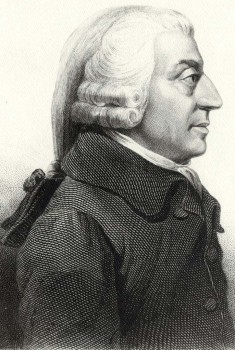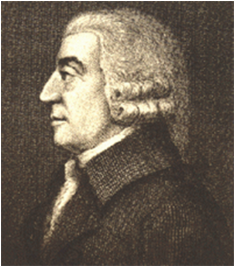| Adam Smith | |
|---|---|
 |
|
| Philosopher | |
| Specialty | Morality, political economy |
| Born | June 5, 1723 OS Kirkcaldy, Fife, Scotland |
| Died | July 17, 1790 (at age 67) Edinburgh, Scotland |
| Nationality | British |
Adam Smith was a very popular Scottish philosopher. He was also a pioneer of political economy and a very important figure in the Scottish Enlightenment. Some of his most popular works include The Theory of Moral Sentiments in 1756 and The Wealth of Nations in 1776.
Early Life
Adam was born in Scotland in 1723. His dad was a Scottish writer, advocate, judge and comptroller of customs in Scotland. On June 5, 1723, Adam was baptized into the Church of Scotland. As a young boy, he was very close to his mother who motivated him to pursue his scholarly ambitions. Between the years 1729 and 1737, he studied Latin, mathematics, writing and history.
Educational Years
Adam was admitted to the University of Glasgow when he was only 14 years old. Here, he studied moral philosophy under Mr. Francis Hutcheson. In this university, he developed a great passion for free speech and liberty reason. In 1740, he was presented to pursue his postgraduate studies in Balliol College in Oxford.
However, some officials discovered that he was reading a copy of David Hume. As a result, the book was confiscated and he was seriously punished for this. Despite this, Adam Smith used most of his time in the university reading many of the books from the shelves in the university’s library. In 1746, he left Oxford University before his scholarship even ended.
Career Highlights
In 1748, Smith started giving public lectures at the University of Edinburgh. In this university, he was able to meet his longtime friend, David Hume, who was a popular Scottish philosopher and economist. The relationship between the two led to Adam’s appointment to the Glasgow University faculty in just three years later.
In 1759, Adam managed to publish his book entitled Theory of Moral Sentiments. This book’s main content was that human morality greatly depends on sympathy between an individual and other members of the society. Between the years 1763 and 1766, he became the tutor of the Duke of Buccleuch and even travelled with him all the way to France. In France, he was able to meet and interact with other great thinkers such as French economist Turgot and Benjamin Franklin.
Following the book’s publication, Smith became so popular than many rich students left their home schools to join Glasgow in order to study under him. He also started giving more attention to economics and jurisprudence in his lectures. In 1762, the University of Glasgow conferred on Adam Smith the title of Doctor of Law.
The Wealth of Nations
 After a period of nine years, Adam Smith was finally able to publish his book entitled The Wealth of Nations. This is basically a book dedicated to the study of political economy. During this time, the field of economics was simply dominated by an idea that a nation’s wealth was measured by its store of silver and gold. Smith therefore proposed that the country’s wealth must be judged by the total of its production and commerce (now GDP) and not by its metric.
After a period of nine years, Adam Smith was finally able to publish his book entitled The Wealth of Nations. This is basically a book dedicated to the study of political economy. During this time, the field of economics was simply dominated by an idea that a nation’s wealth was measured by its store of silver and gold. Smith therefore proposed that the country’s wealth must be judged by the total of its production and commerce (now GDP) and not by its metric.
In this book, Adam Smith also explored different theories of labor division which led to a qualitative increase in productivity. He also stated that free-market economies are the most productive to their societies. This book won Adam a great reputation. His work is considered to be one of the most influential books ever written about economics and politics.
Smith’s Honors and Legacy
In 1766, Adam returned home to Kirkcaldy. He devoted the next 10 years to his magnum opus. In 1773, he was elected fellow of the Royal Society of London. Later in 1775, he was elected to be a member of the Literary Club. In 1778, Adam was appointed to be the commissioner of customs in Scotland. He went to live with his mother and five years later, he became a founding member of Royal Society of Edinburgh.
Very little is known about Adam Smith personal views except what is deduced from his published books and articles. His own personal paper was actually destroyed after his death as per his request. Adam was never married but he always had a very close relationship with his mother.
Some biographers have described Smith as comically absent-minded. Since childhood, he was known to talk to himself. He also had occasional spells of some imaginary illness. Adam Smith died in Edinburgh on July 17, 1790, following a very painful illness.